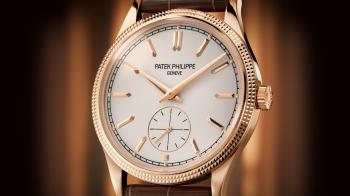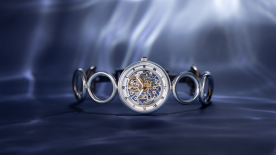The relentless frenzy over Patek Philippe’s steel and sporty models has many confused. At heart, Patek Philippe is all about slim, classic and refined timepieces fitted with exquisite movements and housed in precious metal cases. They are what is commonly called timeless, although that doesn’t proclude updates. On the contrary, it is through slight redesign that a timepiece collection can withstand the passing of time. It is therefore in the spirit of longevity that the Geneva brand has set about the very delicate task of releasing a new generation of one essential, fundamental watch, the Calatrava with Clous de Paris bezel.
A matter of size
A new Calatrava “Clous de Paris” may seem like not so big a deal, but it actually is because after its 1985 release, this design became integral to Patek Philippe’s identity: a statement of design, of watchmaking, of refinement throughout. Available in a new, broader, 41mm diameter, in a choice of white gold framing a charcoal gray dial or rose gold with a light silver grained dial, it is powered by a slim and wide hand-wound caliber specially designed for the occasion. Which means that behind a recognizable, 36-year old appearance, Patek Philippe has in fact changed almost everything.

A matter of light
The smaller-sized Calatrava Refs. 5196 and 5227 are still mainstays of the Patek catalog. At respectively 37 and 39mm, they show how very gradual the collection is. Yet the new Ref. 6119 models feature one of the most emblematic details and recognizable details of the collection: the Clous de Paris bezel. The three-dimensional pattern is obtained by the traditional technique of guilloché. The Calatrava’s idiosyncratic approach has always been the double-row Clous de Paris hobnail pattern. More surfaces and more angles provide the timepiece with enhanced light effects and a genuine signature.
A matter of feel
The Calatrava “Clous de Paris” dial echoes the faceted surfaces of the bezel. Each hour-marker is a solid gold applied index with four facets, positioned as an extension of a rounded and polished nail marker located on the railroad minute track. Underneath it all, the dial itself comes in two flavors. On the rose gold version, it has a powdery, silver-toned surface, whose matt finish makes a striking contrast with the overall glow of the surrounding polishings. The effect is similar on the white gold Calatrava, but instead of a very fine grain, Patek Philippe has chosen a more modern vertical satin finish, while the small seconds display features a snailed pattern. Instead of representing a mere change in materials and colors, the personality of the 6119 G feels different from that of the 6119 R.
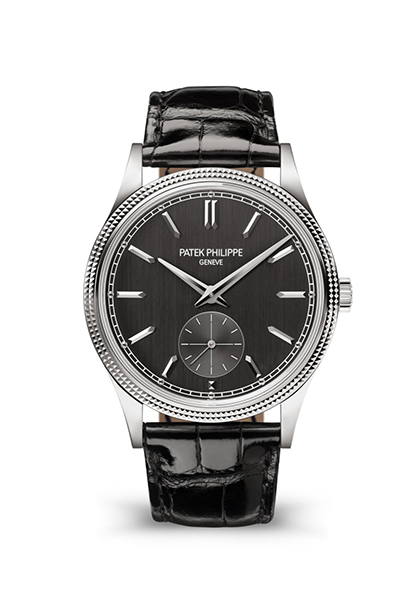
A matter of movement
Altering the Calatrava’s size is indisputably meaningful, since enlarging a dress watch 33mm to 39mm has deep implications in terms of the image it projects. These Calatrava “Clous de Paris” models are thus now the largest members of the family and this new stature called for a movement sized accordingly. Its width is guided by the position of the small seconds. Too small a caliber would position it too high up and too close to the central hands, creating a design imbalance that Patek Philippe could not tolerate. Since there was no caliber large enough in the brand’s stables, the only option was to create a new one.
A matter of architecture
The new 30-255 caliber is 31mm wide, a new large size for a three-hand movement stemming from the Geneva-based Manufacture. This size enabled two barrels to be fitted rather than just one. Instead of making them provide a longer running time by placing them one after the other, Patek Philippe decided to turn them to a different advantage. Both mesh on either side of the first wheel pinion, providing smoother, more regular torque to the gear train and thus resulting in better chronometry as well as less strain on the pivots. This is no negligeable attribute, given the movement’s slender 2.5mm thickness and indeed plays a key role in preserving its reliability, slim movements being notoriously fragile. Moreover, this set-up still manages to provide a 65-hour power reserve. The 30-255 is of course finished to the highest standards as defined by the criteria of the Patek Philippe Seal.
Blue is the face
Blue may be the new black, the new gray, or the new white depending on who you listen to. But to Patek Philippe, no one color has ever ousted or dominated the others. So it’s in a spirit of moderation that the Manufacture has decided to release three watches dressed in blue, with very different dials. The first one is a sophisticated guilloché, a pattern of twelve sectors, separated by powdered gold hour markers of the Calatrava 4997/200G. This dial used to be fitted in a 33mm, hand-wound timepiece. It’s been upgraded to an automatic movement, widened to a more modern 35mm diameter, and set with 76 diamonds adorning its white gold bezel.
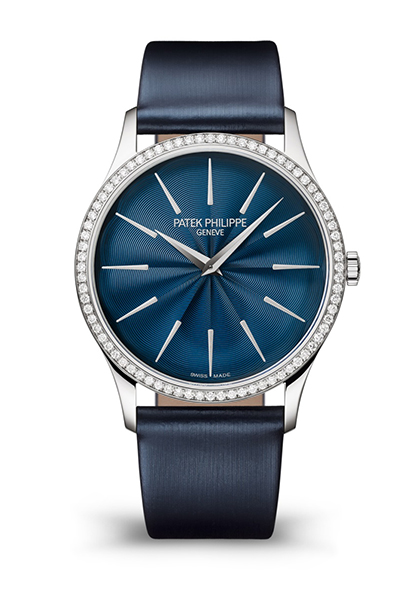
More than just steel
The Annual Calendar Ref. 4947/1A will appeal to the sartorial-savvy part of Patek Philippe’s clientele. Any complicated Patek Philippe made of non-precious metal is of special interest. But the pattern on the dial is also a main attraction here. Composed of very fine vertical and horizontal lines, it recalls the warp and weft of Shantung. This cloth of Chinese origin has lately become popular in very high-end neckties because the irregular thickness of the yarn gives it a sophisticated, uneven feel.
More than just blue
Nonetheless, the most important piece of news in the Patek Philippe array of blues is Ref. 5236P. Not only because of its deep shade, lighter in the middle, darker around the edge. Not just because of its dial’s thin vertical satin finish. Partly because of its streamlined, 41.3mm platinum case. But mostly because Patek Philippe released it with a brand-new perpetual calendar mechanism which results in a very unusual layout. Day, date and month are positioned in a single line, in a single aperture. The In-line Perpetual Calendar is a statement: Patek Philippe may be a classic brand, focused on the preservation of tradition and excellence in watchmaking, but it will relentlessly manage to further improve this art.
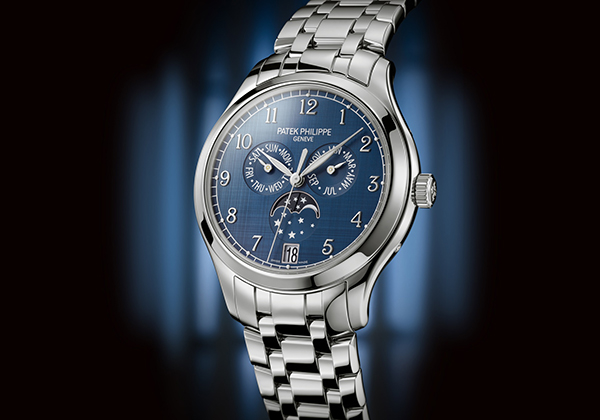
More than just practical
A first indication of that determination is the fact that the 5236 is an automatic timepiece. If it’s not worn daily – and we can agree that at that level of sophistication, this will not be its owner’s only watch – a perpetual calendar stops. When picked up again, its date indications must be re-set; this can be a pleasurable moment, but also a tedious one. So to keep things practical, many amateurs own a watch winder… which will only be of use with an automatic timepiece.
More than just smart
Patek Philippe started by summoning one of their most discreet movements, one that’s barely known to the public – and for good reason, since it has only been used in a very limited number of watches, themselves released in very limited numbers. Caliber 31-260 is a beautifully designed, wide automatic movement fitted with an off-centered solid platinum rotor, which makes it both rather thin and powerful. After a series of aesthetic alterations (especially the shape of the bridges) aimed at making it more beautiful, it was the perfect candidate for the adjunction of a perpetual calendar mechanism. Deeply embedded in the base caliber, the parts responsible for computing the day, date, month, leap year, moonphase and day/night indication contribute to an entire movement measuring a mere 5.8mm thick.
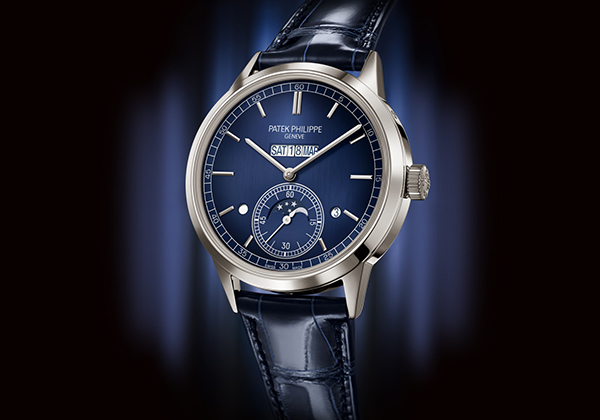
More than just ergonomic
The main attraction here is of course the in-line display. A first set of two concentric disks is in charge of the day and the date’s tens. It is intricately coordinated with a second set, which displays the date’s units and the month. This has led Patek Philippe to file a total of three patents, given the complex technical requirements involved in this unusual organisation of space and motion. As always with watchmaking complications, the aim is never to let the wearer know about all this complexity (unless they ask). Instead, they are provided with a quickread, thorough and original date, enshrined in a gorgeous Patek Philippe timepiece.
